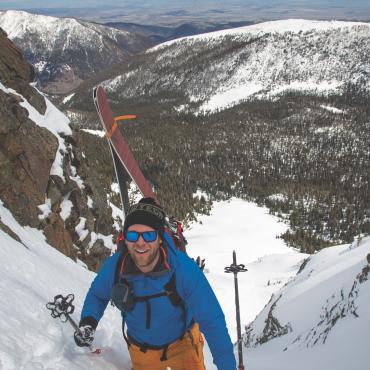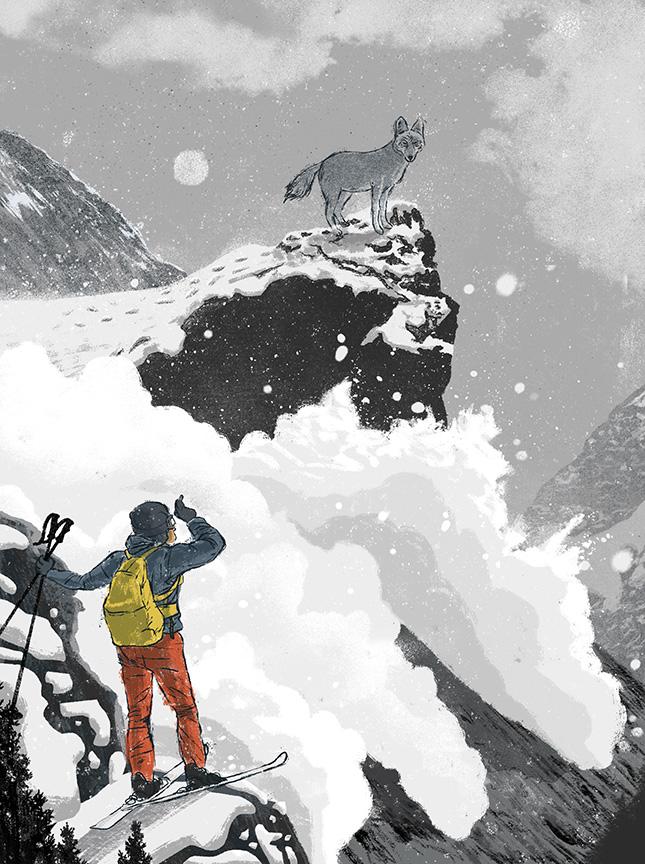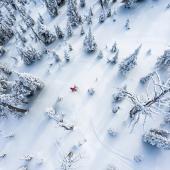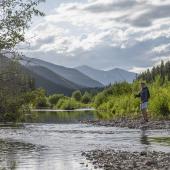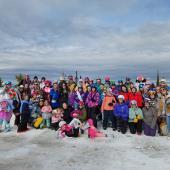On the Hunt
When a coyote comes calling.
He appeared to me near the river, alone in the cold, and stood watching as I skied closer. Mangy-looking thing, I thought.
But I was alone too. The backcountry is my sanctuary from humanity. It’s all that is wild. So I sometimes ski along the winter river, its high banks rimmed by intricate, gnarled cornices of snow, hoping, for a while, to be wild too. And that day, he was waiting.
He watched me, but didn’t run. Like the river flowing over thick cascades of moon-colored pancake ice, the way he moved was inimitable, inevitable. He lowered his head and shifted his weight from foot to foot contemplatively. And then he stood upright, brown-edged ears erect. He turned deliberately and dashed up the steep 50-foot riverbank, the only clue to his passing a trail of prints in the snow. Intrigued, I followed.
Clambering up the boulder-strewn bank in pursuit, I wondered why he was alone. Maybe he was hunting. Maybe he was a vagabond. Maybe he just wanted to explore the uninterrupted beauty of the mountains in peace. Maybe we shared more than a moment by a river, I thought.
At the top of the bank he was waiting, sitting in the afternoon shadow of a large boulder with his bushy tail curled around his haunches. His expression was that of a comic sage; a Chaplin-esque monk. He had quiet brown eyes, curious and skeptical and cynical and proud. But he didn’t run. He just looked at me and sat, while I breathed heavily and looked back at him.
Alone, it becomes easy to see and hear things. The river sounds different. It’s softer, and duller. Like shouting into a pillow. Snow speaks as well. It squeaks and whispers in lost Arctic tongues. And all around is an unsoiled beauty that defies any human construct. Ambition, expectation, and disappointment fade to the clarity of frigid survival. Winter immaculate.
I watched him sitting by the boulder, and I was afraid. He was small, but powerful. Each movement was efficient, each twitch deliberate. Even from a distance, I could see his lean, muscular form rippling under a thick winter coat. Glossy and oaken, highlighted by streaks of blond and chocolate-sepia, he was elegant and commanding. Stepping up the mountain, he looked back, smiling through parted lips and exposed incisors. He was a beautiful fright.
Pacing in small circles, he kept his head low, and his eyes never left mine as I stepped into my skis. He was beckoning, demanding that I follow. Bending over to secure my bindings, I was conflicted and uneasy and awed, and I rationalized.
It was just one little coyote after all. I could spear him with a ski pole if he attacked. I could beat him; stab him; kill him. He would lie in the snow, melting into a bloody stain like a bowl of spilt punch, and his brown eyes would blacken until they demanded nothing, and The Order of Things would be restored. This is what I thought as I began skiing, following the coyote. But he didn’t attack, and I didn’t kill. He walked, and I skied, and we climbed the mountain together.
He kept a considerable distance between us, but never strayed. And he set a good track; not too steep, not too exposed. He knew this mountain well. But he paused for a moment near the top of the climb. His delicate muzzle probed the sky like an oscillating sieve; a million scent molecules percolating in an instant. They told him everything about this place. About me.
And he changed course, veering from a logical route that would lead us to the summit. This is the place he will leave me, I thought. I’ll ski, and he’ll live and everything will be the same. But he trotted a short distance, and then he turned, and his direct gaze beckoned me once more.
I don’t know why I followed. I don’t often follow moose or deer, or ravens or eagles. They’re remembered in passing; novelties that somehow enrich the day with wild flavor. They’re talked about over dinner for one or two sentences and then forgotten. So even as I skied behind, watching his lithe form move smoothly over the snow, I asked myself why I was there. And I knew then how it must have been, when man first found himself in wild company. I trusted him. I trusted his innate competence. Maybe it wasn’t we who tamed the beast, I thought, but the other way around.
The coyote and I worked together to the ridge. He was waiting again as I crested the final climb, with the peak only yards away. Sitting innocently on the snow, my guide was composed and curious, and his thick tail slowly swept over the snow in easy pendulum strokes. We stared again at one another for a moment, judging. Then I shuffled slightly and he startled. Twitching to his feet, he trotted—slender paws drumming in 2/4-time—to the true summit. There he turned into a north wind that blew his coat into waves of earthy color, and our eyes met once more. He bared his teeth and put back his head, and seemed to laugh. And then he was gone.
On the scalloped ridgetop slab, his tracks remained only a short while. Wind-driven snow eroded them in moments, and they faded like dawn frost from a windowpane. I watched them lose warmth, lose definition, and finally become lost altogether. The last physical reminder of the coyote blew south, and I was alone again on the mountain.
Preparing for my downhill run, I thought of him. How strange. Looking over the edge, to the 1,500 vertical feet of snow and slope below, I could faintly make out our tracks. It was good route, I thought. It was a good climb.
I pushed off and skied over a series of gentle benches, and where the slope rolled over steeply, I slowed to see what lay below. In that moment, the snow didn’t speak. It shrieked; a wrenching, tearing battle scream. A crack arced between my feet, and, like a great jaw opening to reveal fang upon icy fang, the avalanche broke free. I lunged uphill, and watched as the entire mountainside fractured. The scream became a deep, jet-engine rumble as sofa-sized blocks of snow liquefied and sailed into the abyss. A hunk of pure white flesh was ripped from the body of the peak, and from the wound bled bare black earth. Perched safely above the avalanche crown, I breathed a sigh of relief as the slide slowed and the snow settled, and it was then that I saw it.
My intended ascent path was gone—an exposed rocky scar. There is little doubt that the avalanche would have taken me. Not far away, where the coyote stopped and sniffed for a moment, our tracks remained, climbing safely away from the slide. He had known.
Some say I’m a fool for skiing alone. You could have died, they say. What were you doing out there anyway? But it’s difficult to explain; escaping my own humanity or pursuing some vague idea of wild nature. So I say I was following a coyote, and some nod, as though they often follow coyotes up mountains. Most don’t understand. They say the coyote was probably running away from me, afraid and confused. Some even say he was waiting for the avalanche to take me, so that he could scavenge my remains.
But I prefer to think that he was just a solitary coyote searching for something. As I was searching. And there, by the syrupy winter river, we found one another. With wary understanding, we climbed a mountain together—and he helped me live.
This story originally appeared in the literary anthology Wild Moments: Adventures with Animals of the North in 2009.

